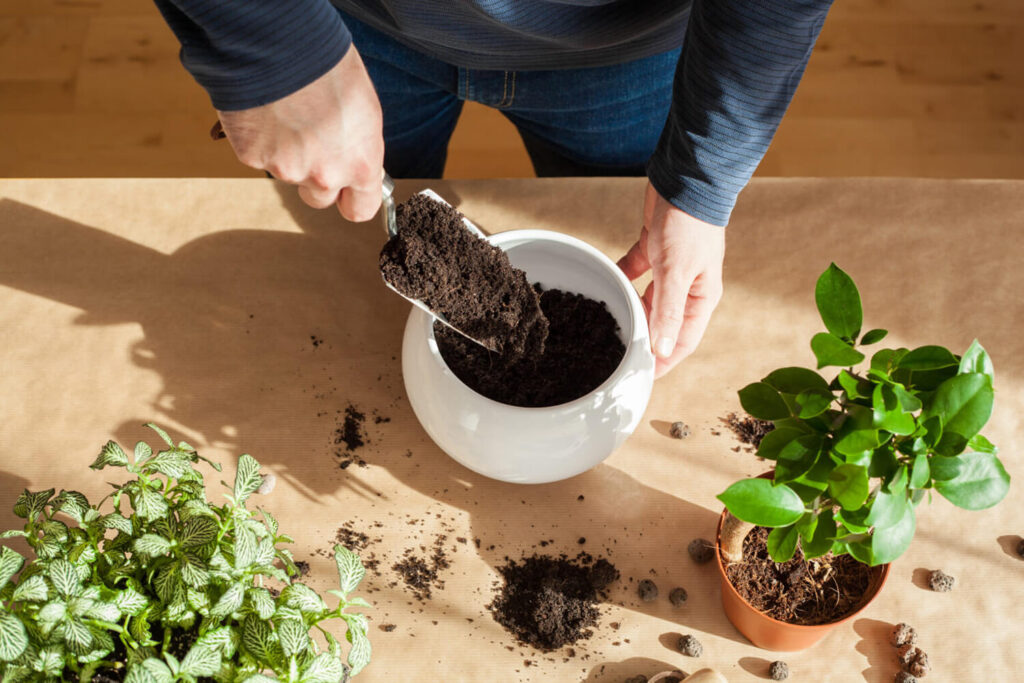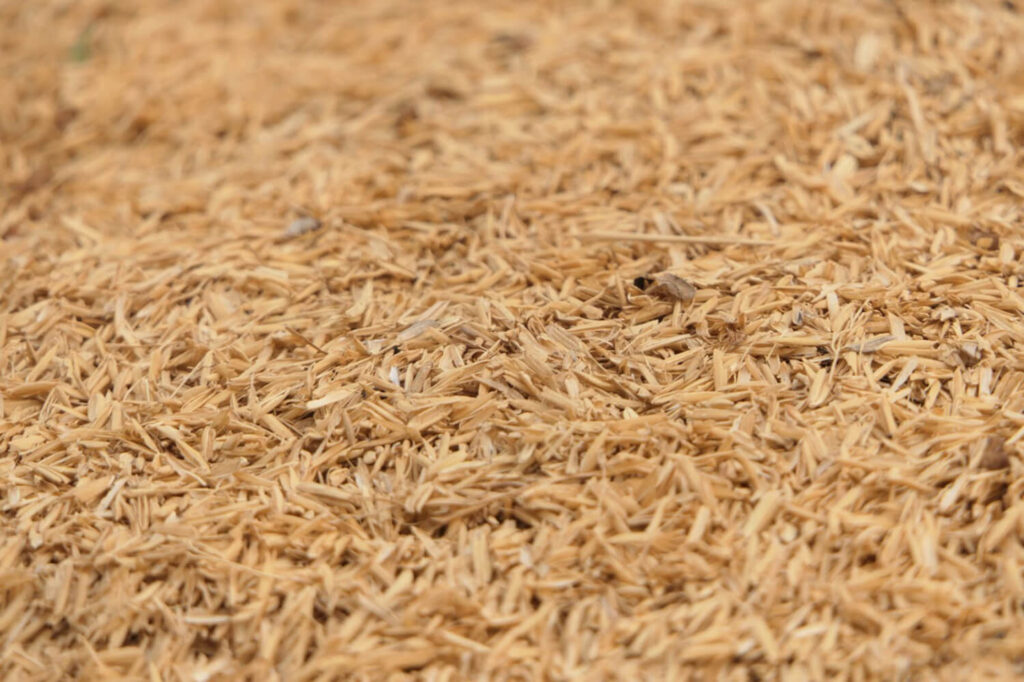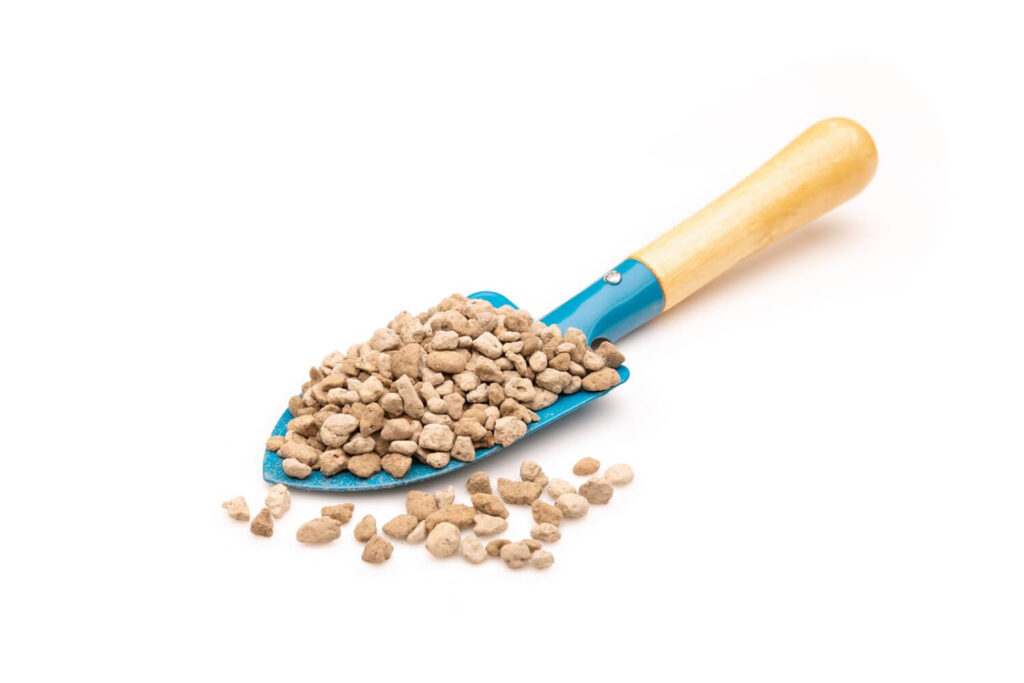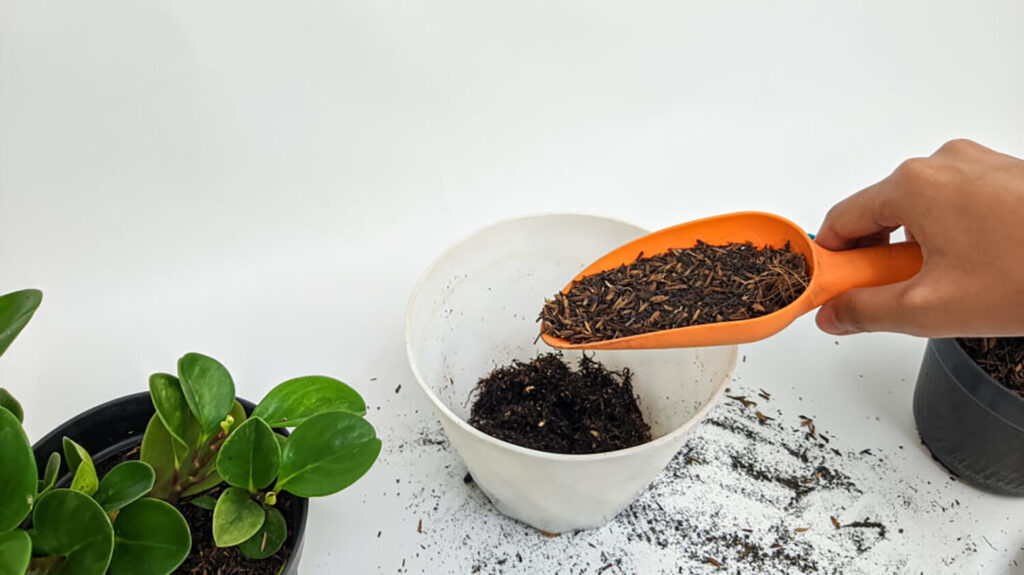DISCLAIMER: Hooked on Bonsai is a participant in the Amazon Services LLC Associates Program, an affiliate advertising program designed to provide a means for sites to earn advertising fees by advertising and linking to Amazon.com. Amazon and the Amazon logo or trademarks of Amazon.com, Inc. or its affiliates.
Want to grow a vigorous bonsai tree that lives for several decades? Then, plant your tree in coarse, well-draining bonsai soil.
Unlike typical potted plants, bonsai trees are somewhat “special.” They require special care and maintenance along with special growing supplies.
To grow a thriving and beautiful bonsai tree, you must place it in a well-nourishing and sustaining environment. One best way to do that is to plant your bonsai tree in true “bonsai soil.”
What does bonsai soil contain? What benefits does it provide? Let’s find out!
Continue reading to learn:
- 5 top-rated bonsai soil DIY blends to use on your bonsai tree.
- Common organic and inorganic components in bonsai soil.
- Best bonsai soil recipes for specific tree species and climates.
- How to mix your own bonsai soil at home and the tools you need.
- And so much more…
What is Bonsai Soil, and Why Do You Need It?
As the name implies, bonsai soil is a type of soil specifically blended for growing bonsai trees.
Unlike normal potting soil, it contains larger-sized and coarse components, such as conifer bark, clay, and crushed lava rock. That’s why many bonsai growers call it a “substrate” rather than a “soil.”
“Is it really necessary to use one?” you may ask.
The answer to that is yes, for two main reasons:
- Bonsai trees are high-maintenance.
- Bonsai trees are more delicate than other plants, especially when grown indoors.
Let me explain further…
Growing a bonsai tree, if we look at it at the surface level, means limiting the tree’s physical growth by constraining it in a small plant pot—and doing that can be very challenging. That’s where using unique nourishment comes in.
By using DIY bonsai soil, you help ensure that your tree gets the right amount of nutrients it needs to grow and develop despite being in a very limited space.
Bonsai Soil/Substrate vs. Garden Soil: What’s the Difference?

Now that you are familiar with bonsai soil, or substrate, let’s discuss what makes it different from a typical garden potting soil.
Many things contribute to a bonsai’s healthy growth and development, such as proper watering and fertilization. However, without good bonsai soil, the water and fertilizers you put into your tree are nothing.
Given that, how can you ensure that your soil is good?
There are three important qualities a good bonsai soil should have:
- Proper drainage: the ability to allow excess water to exit the pot.
- Good water retention: the ability to retain enough water to nourish the tree.
- Sufficient aeration: the ability to allow oxygen to pass through and reach the root tips.
Sure, typical garden soils can have these qualities too. Yet, this type of soil clumps up over time, leaving little to no space for air and water to pass through.
And so, it results in:
- Root rot
- Underdeveloped roots
- Overwatering or underwatering
- Root tips not taking up fertilizers
- Oxygen not reaching the root tips
Which weakens or, worse, kills the tree.
Meanwhile, bonsai soil substrates have larger particle sizes. These larger-grained components let water and air pass through easily.
Bonsai Soil Components
Before you attempt to mix your DIY bonsai soil, you must first learn the common components used in many bonsai soil mixes and what they are used for. That way, you’ll know what’s best suited for your tree.
There are two categories of bonsai soil components: organic and inorganic.
Organic Components
Organic components are materials collected from nature.
Since they come from natural resources, they provide extra nutrients and minerals to the soil, helping trees grow and develop even better. However, one major downside is that organic matter breaks down and decays easily. Once it happens, it may affect the soil’s draining qualities, which may cause “wet feet.”
To summarize, here are the pros and cons of organic components:
Pros
- Environmentally sustainable
- Provide extra nutrients and minerals
Cons
- Breaks down easily
If you want to add organic components to your bonsai soil mix, here are the most commonly used ones:
- Rice hull
- Pine bark
- Peat moss
1. Rice hull

Best for: Water retention
Rice hulls are the brown protecting coatings in unprocessed rice grains.
Many bonsai growers use these as a substrate for their soil since rice hulls are quite good at retaining water. It’s used as a substitute for perlite and vermiculite. Since these have larger particles, they also help create air pockets and efficiently drain excess water out of the bonsai pot.
2. Pine bark
Best for: Drainage and aeration
This particular organic component is used to help retain moisture in bonsai mixtures, and they are processed before they are sold to slow them from breaking down.
Pine bark substrates have various particle sizes. Depending on how much aeration your mixture needs, you can get a ⅜ inch or ⅝ inch one.
3. Peat moss
Best for: Water retention and drainage
At first glance, peat moss looks like typical garden potting soil. However, compared to the latter, it’s loose and spongy in touch.
Also known as “humus,” this organic component comes from dark brown, dead fibrous material. It’s made of fully decomposed mosses and other organic material from peat bogs. It also retains moisture the most, so you may want to add it sparingly in your DIY bonsai soil mix unless your tree species requires more moisture or you live in a region with a dry climate.
Inorganic components
Inorganic components have little to no organic compounds. In addition, most of these substrates are porous and don’t condense or break down easily, which makes them great soil materials. They also have larger particle sizes which help enhance drainage and provide proper aeration to the tree’s root system.
The only downside with inorganic components is that they don’t absorb water and nutrients the same way as their organic counterparts. You’d have to compensate for it by fertilizing and watering your tree more frequently.
Here are the pros and cons of inorganic materials:
Pros
- Porous
- Do not condense
- Do not break down easily
- Have larger particle sizes
Cons
- Retains less water and nutrients.
Some inorganic components commonly used in bonsai soil mixtures:
- Grit
- Perlite
- Turface
- Pumice
- Akadama
- Rice rock
- Lava rock
1. Grit
Best for: Drainage and aeration
Grit, or fine gravel, is one of the most common substrates used in bonsai soil mixes. It has large particle sizes ranging from 0.15 inches (4 mm) to 0.31 inches (8 mm), which are great for promoting good drainage and aeration on the soil.
Suppose you live in a region with a wet climate. Add more grit to your mixture. Doing this helps prevent the risk of overwatering and retaining too much moisture—which eventually leads to wet feet and root rot.
2. Perlite
Best for: Water retention, drainage, and aeration
Perlite is a white, lightweight additive used in many bonsai soil mixtures. Aside from bonsai art, it’s also used in various industries, such as masonry construction.
It’s a type of volcanic glass mined and heated to 1600°F (871°C). Since it’s porous and has large particles, it makes a good component for enhancing water retention, drainage, and aeration.
Depending on your tree’s needs, you can get coarse or fine-grade perlite substrates.
3. Turface
Best for: Drainage and aeration
Turface is also one of the most popular additives in bonsai soil blends. It’s a type of mineral heated to 1500°F (816°C), turning it into a calcined clay. Since it’s a clay material, it retains moisture very well.
Additionally, like perlite, it has large particle sizes, improving the soil’s drainage and aeration.
4. Pumice

Best for: Water retention, drainage, and aeration
Pumice is a type of lightweight volcanic rock. It’s commonly used in bonsai soil mixes for improved drainage and aeration. More so, for good roots ramification.
Although it’s technically a “rock,” it can still hold a good amount of water due to its being porous. However, of course, not as good as other clay-type inorganic components.
You can get pumice substrates in various particle sizes ranging from 1/16 to 7/16 inches.
5. Akadama
Best for: Water retention and drainage
Akadama is a brown, hard-baked Japanese clay additive that was produced specifically for growing bonsai trees.
This component can drain and retain water very well. Additionally, since it has large particle sizes that range from 1/16 inch to 1/2 inch, it also helps promote good soil aeration.
However, one major downside of akadama is that it tends to break down after about two years. That’s why, if you’re using akadama, you should repot your bonsai tree more frequently to ensure good quality soil.
Before adding it to your mixture, sift it first to remove dust-like particles, which can clog the bonsai pot drainage holes over time.
Some bonsai growers find molar clay cat litter a good substitute for akadama. Learn more about their advantages & disadvantages through this video:
6. Rice rock
Best for: Water retention, drainage, and aeration
Rice rock or limestone pea rock is another good additive for bonsai soil.
It’s a crushed angular limestone aggregate that often comes in ¼-inch grades, providing good drainage and aeration to the soil. It can also hold some moisture since limestone is a naturally porous material.
7. Lava rock
Best for: Drainage and aeration
Lava rock is another volcanic rock bonsai substrate. Like other similar components, it’s highly porous, so it retains water well. It’s also incredibly coarse and has a large particle size compared to standard soil, making it a popular choice for enhancing the soil’s drainage and aeration.
Since it doesn’t break down easily, you can ensure that your tree gets the right amount of water and fresh air it needs to develop when you use it. Suppose you live in a region that has a wet climate. Add more lava rock into your mixture to ensure good draining qualities.
Before we head on to the next section…
Let’s quickly review the most common bonsai soil components and their best qualities through this table:
| Water retention | Drainage | Aeration | |
| Rice hull | ✓ | ||
| Pine bark | ✓ | ✓ | |
| Peat moss | ✓ | ✓ | |
| Grit | ✓ | ✓ | |
| Perlite | ✓ | ✓ | ✓ |
| Turface | ✓ | ✓ | |
| Pumice | ✓ | ✓ | ✓ |
| Akadama | ✓ | ✓ | |
| Rice rock | ✓ | ✓ | ✓ |
| Lava rock | ✓ | ✓ |
Can I Mix My Own Bonsai Soil?
Mixing your own DIY bonsai soil is possible. In fact, it’s highly encouraged by expert bonsai artists since, as a tree caretaker, you know exactly what your bonsai needs.
However, you must note that doing things independently requires more effort and knowledge. Hence, it’s important to weigh things first so that you’ll know whether mixing your own bonsai soil would be worth it or not.
To weigh things out, let’s list the advantages and disadvantages of DIY-ing a blend vs. buying a pre-mixed one.
Mixing your own bonsai soil
Advantages:
- Gives you ultimate control over the ratio of your mixture.
- It allows you to select the components you want to use freely.
- It may save you costs, depending on your component choices.
Disadvantages:
- It may require a series of trials and errors.
- Some components may not be readily available to your region.
- It requires adequate knowledge about each type of bonsai substrate.
Buying pre-mixed bonsai soil
Advantages:
- It saves you time and effort.
- It gives you plenty of options.
- You can consult its effectiveness from past buyers.
- Almost always available in bonsai nurseries and eCommerce stores.
Disadvantages:
- You can’t control the ratio of the mixture.
- Some mixtures may not work well for your tree.
- You can’t replace the components used in the mixture.
Given the advantages and disadvantages listed above, we can say that buying pre-mixed bonsai soil is beginner-friendly. Although it doesn’t allow you to customize the mixture, it allows you to test particular substrates. That would help you identify which components work or don’t work on your tree.
On the other hand, mixing your own blend is best for advanced bonsai growers and those who want to experiment on different substrates.
5 Easy Steps on How to Mix Your Bonsai Soil at Home

If you’ve already decided to mix your own bonsai soil, then make sure not to skip this section.
Here’s a step-by-step guide on how to do it:
Step 1: Figure out your bonsai soil recipe
There are several things you should consider when creating your own mix, including:
- The species of your tree
- The climate in your region
- Availability of the substrates
- The chemistry of different substrates together
If you can’t create your recipe yet, refer to our recommendations below. There, you can find several recipe suggestions for different tree species and climates.
Once you have a recipe to follow, order your substrates at your local bonsai garden centers or online.
Step 2: Prepare your tools
You’d only need two primary tools when mixing your own bonsai soil:
- Bonsai sieve pan
- Any tray for mixing
Note: You’d only need the sieve pan if you’ll be using akadama or lava rock on your mixture. Otherwise, a tray is the only thing you’d have to prepare.
Step 3: Sift the Akadama or lava rock

Note: If you’re not using akadama or lava rock in your mixture, jump to the next step.
You have to sift the akadama to remove the fine dust particles. The same goes with lava rock, but only if your pack of substrates isn’t clean.
To sift them, follow these simple steps:
- Prepare your sieve tool and attach the finest mesh to it.
- Pour the akadama or lava rock into the sieve pan. (Do each separately.)
- Shake the sieve until most of the dust particles have been removed.
- Toss aside the removed dust.
- Then, transfer your clean substrate to your mixing tray.
Step 4: Measure the substrates
Next, measure your substrates according to the ratio of the recipe you’re following. You can weigh your substrates if you want an accurate measurement. Alternatively, you can measure it by eye since it doesn’t strictly need to be exact.
Once measured, pour them into your mixing tray.
Step 5: Mix the components thoroughly
Finally, mix your substrates thoroughly. Shaking the tray and mixing it by hand both help ensure that the substrates are distributed well.
Once done, you can repot your bonsai tree using your blend.
Bonsai Soil Mixture Recipes
As mentioned above, you’d have to consider several things when mixing your own bonsai soil, including your plant species and the climate in your region. So to make things easier for you, I prepared some bonsai soil recipes based on those categories.
Before that, take note that:
You can buy or mix a bonsai soil that’s purely organic, inorganic, or has both types of components—but nothing is superior to the other.Your tree will grow in any mixture as long as the components complement each other.
Recommended recipes based on tree species
For conifer trees
One of the best bonsai soil recipes for conifer trees includes pumice, lava rock, and akadama at a 1:1:1 ratio. Another good recipe is a mixture of calcined clay, pine bark, lava rock, and limestone pea rock at a 3-1-3-3 ratio.
Suppose you don’t have access to akadama. You can get turface or calcined clay as an alternative. Likewise, you can use perlite as a substitute for pumice.
For deciduous trees
Since deciduous trees require more moisture, you’d have to have soil with good water retention qualities.
To do that, you can increase the number of akadama from the above’s recipe. So, for deciduous bonsai, aim for a 1:1:2 pumice, lava rock, and akadama mixture or equivalent.
Recommended recipes based on climate
For regions with a dry climate
If you live in a region with a dry climate, add more akadama or its equivalent to your mixture. That way, your soil mixture can retain more moisture between watering.
One example recipe for this is turface, lava rock, and pumice at a 2:1:1 ratio.
For regions with a wet climate
Growing plants in regions with a wet climate has a higher risk for overwatering. With that said, create a good bonsai soil mix using well-draining soil components. One way you can do that is by adding more grit or lava rock to your mixture.
A mixture that contains akadama, grit, and perlite at a 1:2:1 ratio should work in these regions.
5 Top-Rated Bonsai Blends for Different Needs

1. Leaves & Soul’s Professional All-Purpose Blend
Best for: Conifer trees | Tropical and subtropical climates
Components:
- 30% calcined clay
- 10% pine bark 3/8″
- 30% red lava rock 1/4″
- 30% limestone pea rock 1/4″
Are you looking for a mostly inorganic soil mix? Then, this premium all-purpose blend from Leaves & Soul might be the best option for you.
Since it contains a good measurement of calcined clay, lava rock, limestone pea rock, and bark, expect good water retention, drainage, and aeration from it. The ratio of the components works best for conifer trees, but it can also work well in other bonsai tree species.
2. Tinyroots’ Organic Bonsai Soil All-Purpose Blend
Best for: Nursery-stock bonsai tree
Components:
- Frit
- Pine bark
- River sand
- Vermiculite
- Calcined clay
Suppose you need a mixture that can work well for your first bonsai tree. Try this all-purpose organic soil from Tinyroots.
This mixture is best for nursery-stock bonsai plants that need repotting and also for beginners who don’t know much yet about substrates.
3. Perfect Plants’ Premium Bonsai Soil
Best for: Conifer trees | Tropical and subtropical climates
Components:
- Sand
- Pine bark
- Crushed grit
- Sphagnum peat moss
This bonsai soil mixture from Perfect Plants offers a blend that uses both inorganic and organic materials. It would be the perfect choice if you want to experiment with both types of components.
Since it has good aeration, drainage, and water retention qualities, this mixture can work well in various coniferous tree species, including pines, junipers, and redwoods.
4. Bonsai Supply’s All-Purpose Bonsai Soil
Best for: Trees that need drier soil | Wet climates
Components:
- Pumice
- Pine bark
- Black lava
- Calcined clay
Bonsai Supply’s all-purpose bonsai soil mix uses mostly inorganic components such as pumice, lava rock, and calcined clay. However, it also has one organic component—pine bark—which helps the soil retain water better.
Since this blend is loose, it provides good drainage and aeration. More so, it encourages healthy root growth.
5. Bonsai Jack’s Gritty Mix
Best for: Conifer trees | Tropical and subtropical climates
Components:
- 33% pine bark 3/8″
- 33% monto clay 1/4″
- 33% Bonsai block 1/4″
Are you looking for bonsai soil with a 1:1:1 ratio? Then, grab a pack of Bonsai Jack’s gritty mix.
This mixture uses an equal amount of pine bark, monto clay, and Bonsai block. Bonsai block is a special type of substrate which can be used as a substitute for akadama.
While this can work for various tree species, it’s best used for coniferous trees.
Key Takeaways:
Phew! What a ride.
I hope you’ve learned a lot from everything we’ve discussed above regarding DIY bonsai soil.
Before we finally take off, let’s list down the key takeaways from this article:
- Bonsai soil is essential to ensure the trees’ proper and healthy growth.
- Good bonsai soil has three important qualities: water retention, drainage, and aeration.
- Some substrates, such as akadama and lava rock, need sifting to remove dust particles.
- There is no ultimate recipe for a perfect bonsai soil since its effectiveness varies depending on the tree species and climate in the region.
- There are two classifications of bonsai soil components: organic and inorganic. You can create purely organic soil, purely inorganic soil, or a mixture of both.
And that’s it. Happy bonsai growing!





0 Comments